Living the Life
Good, bad, or difficult as hell, I'm living "The Life" the best I can.

All God's Children
Driving Queen Charlotte
Whiskey and Words
Gossip
How to Clean a Colon Before Surgery
My Articles at Associated Content
My Photos at Flickr
Coastal Commentaries
LA's Demand Studio Articles
Cost of the War in Iraq
(JavaScript Error)
Read/Post Comments (4)



Afternoons with Puppy by Dr. Aubrey Fine and Cynthia J. Eisen
HeavyGlow Flash Fiction Anthology Edited by Stacy Taylor
Blue by J.D. Riso. Also available at lulu

A little history lesson (come on, you know you want to learn)
One of the things I do like about my hometown is the history. It's somewhat unusal and totally american. when i came home with pictures of some of fort smith's historic features, mark teased me about acting like a tourist in the place i grew up, but what can i say? i love history.
i got my love of history from my dad. his library is full, floor to ceiling, with books, both religious and historical. growing up in that area of the country afforded me several historical opportunities and with my father loving everything concerning the civil war, both sides, everytime we took a trip around arkansas, into tenn, or missouri, we stopped at lots and lots of civil war battle fields and historic sites. on the flip side, my mother was into geneology, so i also spent time in various archives digging through birth, marriage, death and military records. as you can see, i didn't have a choice but to love just about everything historical.
now, without further ado....
as i couldn't remember some of the exact dates, the text in quotations come from the Fort Smith National Historic Site.
"On Christmas day, 1817, soldiers of the U.S. Army formally established the first Fort Smith. Isolated on the edge of the American Frontier, these men, under the command of Major William Bradford, were charged with keeping the peace between the Cherokee and Osage tribes.
Officially operational for only seven years, the first Fort Smith marked the beginning of Fort Smith's eighty year history as an agent of Federal Indian Policy."
"The second Fort Smith was established by an act of Congress in 1838, two years after Arkansas gained statehood. The second fort gained a purpose in the 1850s as the "Motherpost of the Southwest," supplying military forts further to the West. The fort was a focal point of Civil War operations in the region, as both armies prized the facility and its location.
In the summer of 1871, U.S. Army troops leave Fort Smith for the final time."
The original fort no longer remains, except for a few walls that have been recently excavated. the picture below is the one building that remains of the new fort (the truck in background is going over the Arkansas River which separates Arkansas from Oklahoma).

"For twenty-five years, Fort Smith served as a base of operations for the federal court. In 1875, Isaac Parker, former congressman from Missouri was appointed to the bench at Fort Smith. For twenty-one years Judge Parker served as Judge, later earning the nickname of "Hanging Judge" for the number of death sentences he handed down.
The jurisdiction of the federal court over the Indian Territory came to an end on September 1, 1896 with the coming of federal courts in the Indian Territory. Judge Parker died two months later."
this is around the time they opened oklahoma up to the land rush, and many of our family's ancestors were "sooners," the name given to land rush participants who didn't wait for the official starting date, but rather took off "sooner" to claim their land.
the picture is the old federal court house. the main, redbricked building was the original court and jail.

original jail under the courthouse.
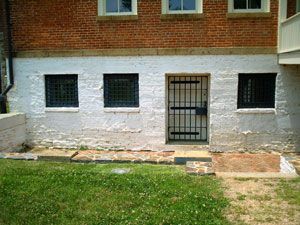
the jail was known as "hell on the border." the conditions were harsh and crowded. (the picture has been lightened to show details, but believe me, it's dark and very cool in temperature.) when we first moved there, visitors couldn't go inside, and could only look through the outside barred door(as seen in the above pic). there was no bedding and big half barrels sat on the stone floor showing the only water the prisoners were allowed, both to drink and bathe in. they've since done extensive restoration which now allows visitors to go inside (tho i think they've "cleaned" things up a bit and whitewashed over the true living conditions.)
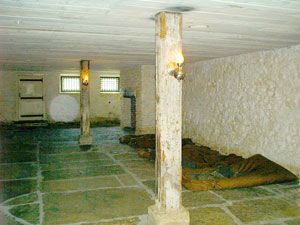
fort smith was the last stop before indian territory(oklahoma). outlaws such as the youngers and belle starr often hid out in the territory because most deputies were too frightened to go there. the government solved this by deputizing african americans, who had no problems entering the territory to look for outlaws. in fact, many african americans befriended the indians and married into their tribes.
the brownstone addition was added later when the jail needed to be extended. this is the cutaway interior shot to illustrate what it looked like.
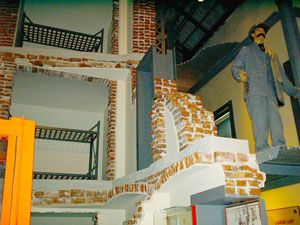
because of it's proximity to indian territory, fort smith was kind of a wild town. even though judge parker had the nickname "the hanging judge," in reality, of over 1000 criminals that went before him, he only hanged about 88 men, one of the most famous being cherokee bill. there are conflicting reports about cherokee bill. some state he has african american along with cherokee, but others say he was a mix of italian and cherokee heritage.
when we first moved to fort smith, we always took visiting relatives to the historic sites. i was about eight years old when we moved there. originally, visitors were allow to actually climb the gallow stairs and place their necks in a noose. i remember always being freaked out about standing over the hatchdoor, afraid it would accidentally release and cause me to fall to the ground below. i'm sure that there were safety issues after a while, and so for a short time, visitors could only look through a hole in the fence at the gallows. now, they've reopened the fence and visitors may once again get up close and personal. however, the stairs remain blocked off and no one may stand on the gallows. when mom and i went in, we saw a notice stating "2 o'clock show" jokingly, i said, "ooo, a two o'clock execution? how exciting." no such luck.
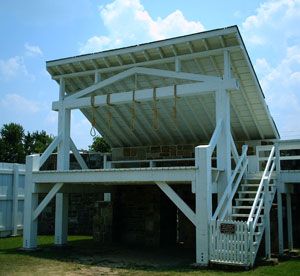
another famous outlaw that frequented fort smith was belle starr. she came and went from indian territory at will. while t.v. depictions of her show her dressing and riding like a man, this is historically incorrect. she always wore a dress and rode side saddle.
elizabeth montgomery starred in a made for tv movie about her (in which she dresses like a man) and belle was rumored to be an occassional lover of cole younger. in the carradine brothers movie about the younger gang, belle is depicted as a prostitute in a bar in texas.
eventually, belle was shot, along with her indian husband, on their land, which i believe was in indian territory.
belle had a daughter named pearl. pearl would become a prostitute and later open her own brothel in the red light district of fort smith, on the riverfront. unfortunately, as fort smith grew, they didn't find an appreciation for their history until much later.
one of the only surviving brothels next to the river is miss laura's house. originally, when it was restored, it was a restaurant. a few years later, the restaurant went under and the city bought the house and now use it for their tourist information site.
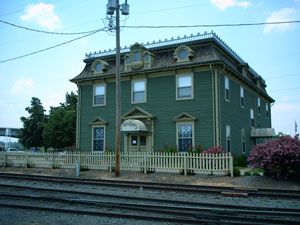
"lonesome dove" also touches on fort smith. the sheriff who goes in search of his wayward wife, was, in the book and movie, the sheriff of fort smith. unfortunately, much of the information in the book is historically incorrect and doesn't depict the true size and status of the town at that time.
fort smith's history and close proximity to indian territory was the inspiration for my short horror story, "There is no God West of Fort Smith" that phrase was their moto, and reflected their attitude of being the last bastion of civilization before entering the godless, heathen territory on the western side of the town and state.
the story is posted at spoiled ink, but it's only viewable to those on my reader list (basic membership is free and i'll gladly add anyone who wants to read it to my list).
There is No God West of Fort Smith
much later, during world war II (tho it could have been ww I), fort chaffee, which sits on the other side of town (but also borders oklahoma) would become the interment camp for german prisoners of war (mentioned in the book "Summer of my German Soldier"). when elvis was drafted, it was at fort chaffee where the famous pictures of him getting his hair cut took place.
in the seventies, as the vietnamese fled their country, fort chaffee was one of only three places in the u.s. where the political refugees were placed. many citizens of fort smith sponsered them, and they now have a large community in the town.
when castro emptied his prisons in the eighties, fort chaffee once again was the place where those refugees were sent. only this time, because many of them were criminals, they were fenced in and surrounded by rolls and rolls of cantina wire. several escaped and went on mini-crime sprees.
after that, fort chaffee became the training base for the reserves and national guard. in the past few years, it was a victim of the recent base closings and much of the land has been sold off to the city. only a fraction of the fort remains.
coincidently, for those that are interested, fort smith is in sebastian county. at the time of clinton's election to governer of arkansas (the first time), sebastian county was the only republican county in the state.
see there, that wasn't so bad now was it?
;-)
i got my love of history from my dad. his library is full, floor to ceiling, with books, both religious and historical. growing up in that area of the country afforded me several historical opportunities and with my father loving everything concerning the civil war, both sides, everytime we took a trip around arkansas, into tenn, or missouri, we stopped at lots and lots of civil war battle fields and historic sites. on the flip side, my mother was into geneology, so i also spent time in various archives digging through birth, marriage, death and military records. as you can see, i didn't have a choice but to love just about everything historical.
now, without further ado....
as i couldn't remember some of the exact dates, the text in quotations come from the Fort Smith National Historic Site.
"On Christmas day, 1817, soldiers of the U.S. Army formally established the first Fort Smith. Isolated on the edge of the American Frontier, these men, under the command of Major William Bradford, were charged with keeping the peace between the Cherokee and Osage tribes.
Officially operational for only seven years, the first Fort Smith marked the beginning of Fort Smith's eighty year history as an agent of Federal Indian Policy."
"The second Fort Smith was established by an act of Congress in 1838, two years after Arkansas gained statehood. The second fort gained a purpose in the 1850s as the "Motherpost of the Southwest," supplying military forts further to the West. The fort was a focal point of Civil War operations in the region, as both armies prized the facility and its location.
In the summer of 1871, U.S. Army troops leave Fort Smith for the final time."
The original fort no longer remains, except for a few walls that have been recently excavated. the picture below is the one building that remains of the new fort (the truck in background is going over the Arkansas River which separates Arkansas from Oklahoma).

"For twenty-five years, Fort Smith served as a base of operations for the federal court. In 1875, Isaac Parker, former congressman from Missouri was appointed to the bench at Fort Smith. For twenty-one years Judge Parker served as Judge, later earning the nickname of "Hanging Judge" for the number of death sentences he handed down.
The jurisdiction of the federal court over the Indian Territory came to an end on September 1, 1896 with the coming of federal courts in the Indian Territory. Judge Parker died two months later."
this is around the time they opened oklahoma up to the land rush, and many of our family's ancestors were "sooners," the name given to land rush participants who didn't wait for the official starting date, but rather took off "sooner" to claim their land.
the picture is the old federal court house. the main, redbricked building was the original court and jail.

original jail under the courthouse.

the jail was known as "hell on the border." the conditions were harsh and crowded. (the picture has been lightened to show details, but believe me, it's dark and very cool in temperature.) when we first moved there, visitors couldn't go inside, and could only look through the outside barred door(as seen in the above pic). there was no bedding and big half barrels sat on the stone floor showing the only water the prisoners were allowed, both to drink and bathe in. they've since done extensive restoration which now allows visitors to go inside (tho i think they've "cleaned" things up a bit and whitewashed over the true living conditions.)

fort smith was the last stop before indian territory(oklahoma). outlaws such as the youngers and belle starr often hid out in the territory because most deputies were too frightened to go there. the government solved this by deputizing african americans, who had no problems entering the territory to look for outlaws. in fact, many african americans befriended the indians and married into their tribes.
the brownstone addition was added later when the jail needed to be extended. this is the cutaway interior shot to illustrate what it looked like.

because of it's proximity to indian territory, fort smith was kind of a wild town. even though judge parker had the nickname "the hanging judge," in reality, of over 1000 criminals that went before him, he only hanged about 88 men, one of the most famous being cherokee bill. there are conflicting reports about cherokee bill. some state he has african american along with cherokee, but others say he was a mix of italian and cherokee heritage.
when we first moved to fort smith, we always took visiting relatives to the historic sites. i was about eight years old when we moved there. originally, visitors were allow to actually climb the gallow stairs and place their necks in a noose. i remember always being freaked out about standing over the hatchdoor, afraid it would accidentally release and cause me to fall to the ground below. i'm sure that there were safety issues after a while, and so for a short time, visitors could only look through a hole in the fence at the gallows. now, they've reopened the fence and visitors may once again get up close and personal. however, the stairs remain blocked off and no one may stand on the gallows. when mom and i went in, we saw a notice stating "2 o'clock show" jokingly, i said, "ooo, a two o'clock execution? how exciting." no such luck.

another famous outlaw that frequented fort smith was belle starr. she came and went from indian territory at will. while t.v. depictions of her show her dressing and riding like a man, this is historically incorrect. she always wore a dress and rode side saddle.
elizabeth montgomery starred in a made for tv movie about her (in which she dresses like a man) and belle was rumored to be an occassional lover of cole younger. in the carradine brothers movie about the younger gang, belle is depicted as a prostitute in a bar in texas.
eventually, belle was shot, along with her indian husband, on their land, which i believe was in indian territory.
belle had a daughter named pearl. pearl would become a prostitute and later open her own brothel in the red light district of fort smith, on the riverfront. unfortunately, as fort smith grew, they didn't find an appreciation for their history until much later.
one of the only surviving brothels next to the river is miss laura's house. originally, when it was restored, it was a restaurant. a few years later, the restaurant went under and the city bought the house and now use it for their tourist information site.

"lonesome dove" also touches on fort smith. the sheriff who goes in search of his wayward wife, was, in the book and movie, the sheriff of fort smith. unfortunately, much of the information in the book is historically incorrect and doesn't depict the true size and status of the town at that time.
fort smith's history and close proximity to indian territory was the inspiration for my short horror story, "There is no God West of Fort Smith" that phrase was their moto, and reflected their attitude of being the last bastion of civilization before entering the godless, heathen territory on the western side of the town and state.
the story is posted at spoiled ink, but it's only viewable to those on my reader list (basic membership is free and i'll gladly add anyone who wants to read it to my list).
There is No God West of Fort Smith
much later, during world war II (tho it could have been ww I), fort chaffee, which sits on the other side of town (but also borders oklahoma) would become the interment camp for german prisoners of war (mentioned in the book "Summer of my German Soldier"). when elvis was drafted, it was at fort chaffee where the famous pictures of him getting his hair cut took place.
in the seventies, as the vietnamese fled their country, fort chaffee was one of only three places in the u.s. where the political refugees were placed. many citizens of fort smith sponsered them, and they now have a large community in the town.
when castro emptied his prisons in the eighties, fort chaffee once again was the place where those refugees were sent. only this time, because many of them were criminals, they were fenced in and surrounded by rolls and rolls of cantina wire. several escaped and went on mini-crime sprees.
after that, fort chaffee became the training base for the reserves and national guard. in the past few years, it was a victim of the recent base closings and much of the land has been sold off to the city. only a fraction of the fort remains.
coincidently, for those that are interested, fort smith is in sebastian county. at the time of clinton's election to governer of arkansas (the first time), sebastian county was the only republican county in the state.
see there, that wasn't so bad now was it?
;-)
Read/Post Comments (4)
Previous Entry :: Next Entry
Back to Top